I was recently looking at a couple of Q&A's on this site for a description of capacitive pickup of 60 Hz by an oscilloscope probe:
I wanted to do a quantitative analysis of this, so I made the following model:
V is 110 V. V1 is the voltage measured by the scope. Z2 is the capacitive impedance of the coupling of the probe to the power lines. For example, if I'm touching the probe, then this is coming from the capacitor consisting of my body as one plate and the wiring inside the wall as the other. Z1 is the impedance of the probe. I take Z2 to be made out of a capacitance C=1 pF, while Z1 is a resistor R=10 MΩ in parallel with a 10 pF capacitance.
So if I analyze this as a voltage divider, I get V1/V=1/(1+Z2/Z1)≈Z1/Z2. At 60 Hz, the probe's impedance comes out to be almost purely its resistance R, so V1=iωRCV, or ~400 mV, which is the right order of magnitude compared to what I observe.
The reason I'm posting this as a question is that I got into a discussion in comments where we don't seem to be agreeing on the analysis, and it doesn't seem like the kind of thing that is going to be easy to clarify within a comment thread.
In this answer, wbeaty says:
You're seeing a capacitive divider effect. One capacitor is within the scope probe and essentially is connected from the tip to the scope ground. The other much smaller capacitance is across empty space: from the probe tip to any distant 220vac wires in the walls. The empty space around the probe is the dielectric of this capacitor.
In a comment, I said:
I could be wrong, but it seems to me that this is not really a capacitive divider. The scope probe acts like a 1 Mohm resistor in parallel with, say, a 20 pF capacitor. So at 60 Hz, the probe is acting like a resistor, not a capacitor.
Wbeaty replied in a comment:
The Thevenin Equiv of the capacitive divider is 20pF in series with distant 220VAC source, all in parallel with 10Megs as you say ...AS WELL AS THE DIVIDER EFFECT. Perform calcs for three components. Suppose there is 0.01pF between the distant 220VAC line and the probe tip. That gives a 1/2000 divider effect, in addition to a highpass-filter attenuation of 1:15.9 at 50Hz. (In other words, what's the Thevenin equiv. for a capacitive divider using 0.01pF and 20pF? Then place 10Meg on its output, to create a hipass.) Apply 220VAC, and the scope w/floating probe will measure 6.9mV
I don't understand this comment. Can anyone clarify whether one of us is the right and the other person is wrong? Are we using different models, or the same model? I can't tell from wbeaty's verbal description whether he has in mind the same schematic I do.
